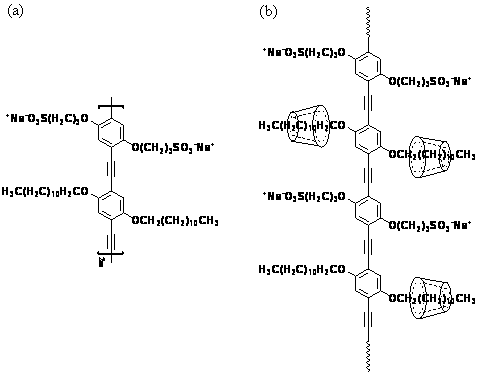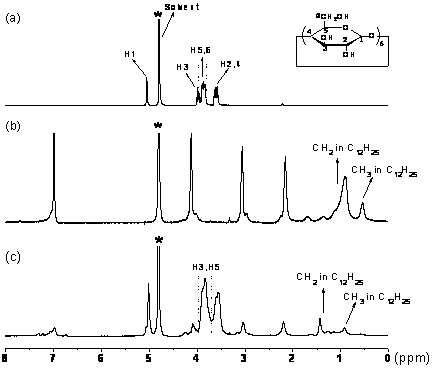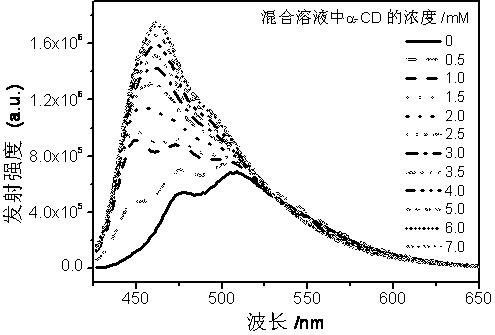Method for adjusting fluorescence performance of conjugate polyelectrolyte
A technology of conjugated polyelectrolytes and fluorescent properties, applied in chemical instruments and methods, luminescent materials, etc., can solve problems such as inapplicable biomolecular detection, improve fluorescence intensity and quantum efficiency, eliminate potential hazards, and sense and detect capabilities enhanced effect
- Summary
- Abstract
- Description
- Claims
- Application Information
AI Technical Summary
Problems solved by technology
Method used
Image
Examples
Embodiment 1
[0021] This embodiment provides a kind of conjugated polyelectrolyte (PPESO 3 OR) the adjustment method of fluorescent performance, concrete steps are as follows:
[0022] 1. According to the technical scheme of Chinese invention patent CN101892045A, the concentration is 1 × 10 -4 M (calculated as the molar concentration of repeating units) poly(arylene acetylene) conjugated polyelectrolyte PPESO 3 OR aqueous solution; the resulting conjugated polyelectrolyte PPESO 3 The OR aqueous solution was divided into 12 parts on average, one of which was taken as a blank control sample, and a small amount of α-cyclodextrin aqueous solution of different concentrations was added to the remaining parts to obtain a mixed solution, so that the concentration of cyclodextrin in each mixed solution changed from 0.1 Start with mM, increase sequentially with a gradient of 0.5 mM, and finally reach a cyclodextrin concentration of 7 mM;
[0023] 2. At room temperature, the above-mentioned mixed...
Embodiment 2
[0028] This embodiment provides a kind of conjugated polyelectrolyte (PPESO 3 OR) the adjustment method of fluorescent performance, concrete steps are as follows:
[0029] 1. According to the technical scheme of Chinese invention patent CN101892045A, the concentration is 1 × 10 -5 M (calculated as the molar concentration of repeating units) poly(arylene acetylene) conjugated polyelectrolyte PPESO 3 OR water solution, according to the method of Example 1, add a small amount of cyclodextrin β-CD aqueous solution, in each mixed solution, the concentration of cyclodextrin starts from 0.1mM, and increases sequentially with a gradient of 0.5 mM, and finally makes the cyclodextrin in the mixed solution The concentration of dextrin is 7 mM;
[0030] 2. At room temperature, vibrate each of the above mixed solutions for 15 min to make them fully interact. image 3 Similar to shown.
Embodiment 3
[0032] This embodiment provides a kind of conjugated polyelectrolyte (PPESO 3 OR) the adjustment method of fluorescent performance, concrete steps are as follows:
[0033] 1. According to the technical scheme of Chinese invention patent CN101892045A, the concentration is 1 × 10 -6 M (calculated as the molar concentration of repeating units) poly(arylene acetylene) conjugated polyelectrolyte PPESO 3 According to the method in Example 1, a small amount of cyclodextrin α-CD and β-CD aqueous solutions were added to the OR aqueous solution. In each mixed solution, the concentration of cyclodextrin started from 0.1 mM and increased sequentially with a gradient of 0.5 mM, and finally Make the concentration of cyclodextrin in the mixed solution be 7 mM;
[0034] 2. At room temperature, stir each of the above mixed solutions for 15 min to make them fully interact. image 3 Similar to shown.
PUM
 Login to View More
Login to View More Abstract
Description
Claims
Application Information
 Login to View More
Login to View More - R&D
- Intellectual Property
- Life Sciences
- Materials
- Tech Scout
- Unparalleled Data Quality
- Higher Quality Content
- 60% Fewer Hallucinations
Browse by: Latest US Patents, China's latest patents, Technical Efficacy Thesaurus, Application Domain, Technology Topic, Popular Technical Reports.
© 2025 PatSnap. All rights reserved.Legal|Privacy policy|Modern Slavery Act Transparency Statement|Sitemap|About US| Contact US: help@patsnap.com



